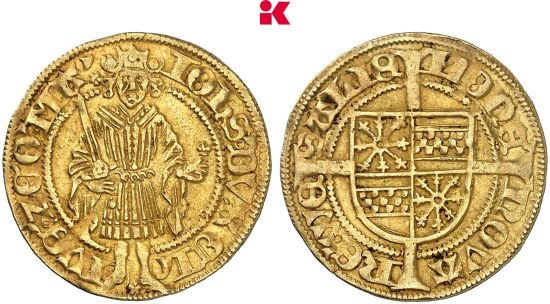Cleves (1497-1521) goldgulden Fr-1369
This specimen was lot 1530 in Künker Auction 425 (Osnabrück, July 2025), where it sold for €3,000 (about US$4,248 including buyers' fees). The catalog description[1] noted,
"DEUTSCHE MÜNZEN UND MEDAILLEN · KLEVE, GRAFSCHAFT, SEIT 1417 HERZOGTUM Johann II., 1481-1521. Goldgulden o. J., Wesel. GOLD. RR Sehr schön +. Exemplar der Auktion Westfälische Auktionsgesellschaft 77, Dortmund 2016, Nr. 1514. (Germany, duchy of Cleves, John II, 1481-1521, undated goldgulden, Wesel mint. Very rare, very fine or better.)
Johann II. hatte am prunkvollen Hof der Burgunderherzöge sein Geld mit vollen Händen ausgegeben. Da die eigenen Mittel für seine Bedürfnisse bei weitem nicht reichten, machte er Schulden. Im Jahr 1479, als er noch Jungherzog war, lieh ihm der kölnische Münzmeister Sybert von Eykening, der wie viele seiner Berufsgenossen nebenbei Bankier war, 800 Gulden. Dadurch erhöhte sich seine Forderung auf 2.500 Gulden, was in jener Zeit ein beträchtliches Vermögen war. Nachdem Johann regierender Herzog geworden war, übernahm sein Münzmeister Herbert von Antorp die Rolle des Geldgebers; er leistete dem Herzog Vorschüsse auf den Schlagschatz, die durch künftig fällig werdende Beträge getilgt werden sollten, und man gewinnt den Eindruck, daß der Herzog hauptsächlich wegen des Schlagschatzes prägen ließ, denn es wurde sehr viel Silbergeld geschlagen; weit mehr als in anderen Gebieten gleicher Ausdehnung. Für die Ausprägung von Goldmünzen brachte das Jahr 1497 neue Bestimmungen: Der Herzog bestätigte am 14. Juli den mit dem verstorbenen Münzmeister Herbert von Antorp und später dessen Sohn Johann geschlossenen Vertrag über die Münzung von Goldgulden. Allerdings sollte die Vorderseiten-Darstellung geändert werden, sie sollte ab jetzt, wie auf unserem Stück zu sehen ist, den Herzog stehend mit Schwert und mit dem gespaltenen Schild Kleve-Mark zeigen. (John II had spent his money lavishly at the expensive court of the Dukes of Burgundy. Since his own resources were far from sufficient for his needs, he ran into debt. In 1479, when he was still a young duke, the Cologne mint master Sybert von Eykening, who, like many of his colleagues, was also a banker, lent him 800 gulden. This increased his debt to 2,500 gulden, a considerable fortune at the time. After John became reigning duke, his mint master, Herbert von Antorp, took over the role of moneylender; he gave the duke advances on the mint treasury, which were to be repaid with future sums due. One gets the impression that the duke minted coins primarily for the mint treasury, for a great deal of silver money was minted—far more than in other territories of the same size. The year 1497 brought new regulations for the minting of gold coins: On July 14, the Duke confirmed the contract for the minting of gold gulden concluded with the deceased mint master Herbert von Antorp and later his son Johann. However, the obverse design was to be changed; from now on, it was to show the Duke standing with a sword and the divided shield of Cleves and Mark, as can be seen on our piece.)"
Wikipedia comments, "Pope Innocent VIII awarded John the Golden Rose of Virtue on 15 April 1489. This is remarkable in light of the fact that John [had] 63 illegitimate children...." His son, John III, married the heiress of Jülich-Berg, joining the two states.
Recorded mintage: unknown.
Specifications: 3.25 g, 0.917 fine gold, this specimen 3,20 g.
Catalog reference: Fr-1369; Noss 154; Schulten 1444.
- Craig, William D., Germanic Coinages: Charlemagne through Wilhelm II, Mountain View, CA: 1954.
- Cuhaj, George S., and Thomas Michael, Standard Catalog of World Coins, 1601-1700, 6th ed., Iola, WI: Krause Publications, 2014.
- Friedberg, Arthur L. and Ira S. Friedberg, Gold Coins of the World, From Ancient Times to the Present, 9th ed., Clifton, NJ: Coin and Currency Institute, 2017.
- [1]Künker, Fritz Rudolf, Horst-Rudiger Künker, Ulrich Künker and Andreas Kaiser, Katalog 425: Gold coins from the Medieval and Modern Times, from the Mohr family collection, e.g. | Silver coins, e.g. highlights of medallic art | German coins after 1871, Osnabrück: Fritz Rudolf Künker GmbH & Co., AG, 2025.
Links:
